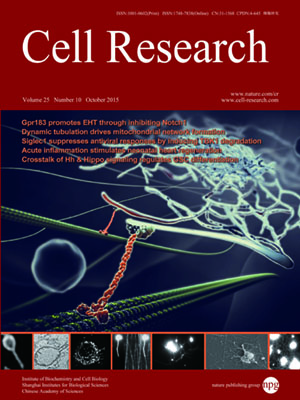
Volume 25, No 10, Oct 2015
ISSN: 1001-0602
EISSN: 1748-7838 2018
impact factor 17.848*
(Clarivate Analytics, 2019)
Volume 25 Issue 10, October 2015: 1121-1136
ORIGINAL ARTICLES
Siglec1 suppresses antiviral innate immune response by inducing TBK1 degradation via the ubiquitin ligase TRIM27
Qingliang Zheng1,*, Jin Hou2,*, Ye Zhou2, Yingyun Yang3, Bing Xie1 and Xuetao Cao1,2,3
1Institute of Immunology, Zhejiang University School of Medicine, Hangzhou, Zhejiang 310058, China
2National Key Laboratory of Medical Immunology & Institute of Immunology, Second Military Medical University, Shanghai 200433, China
3National Key Laboratory of Medical Molecular Biology & Department of Immunology, Institute of Basic Medical Sciences, Chinese Academy of Medical Sciences, Beijing 100005, China
Correspondence: Xuetao Cao, Tel: +86-571-8820 8283; Fax: +86-571-8820 8022(caoxt@immunol.org)
Type I interferon (IFN) production plays pivotal roles in host antiviral innate immune responses, but an excessive production of type I IFN leads to the development of immunopathological conditions. Investigations on the regulatory mechanisms underlying host type I IFN production are currently of great interest. Here, we found that the expression of lectin family member Siglec1 was upregulated by viral infection in macrophages, which was dependent on the IFN/JAK/STAT1 signaling pathway. Siglec1 was found to negatively regulate viral infection-triggered type I IFN production. Mechanistically, Siglec1 associates with DAP12 to recruit and activate the scaffolding function of SHP2; SHP2 then recruits E3 ubiquitin ligase TRIM27, which induces TBK1 degradation via K48-linked ubiquitination at Lys251 and Lys372. Therefore, viral infection-induced upregulation of Siglec1 feedback loop inhibits type I IFN production and suppresses antiviral innate immune responses. Our study outlines a novel mechanism of negative regulation of type I IFN production, which may help virus to escape immune elimination.
10.1038/cr.2015.108
FULL TEXT | PDF
Browse 2547


